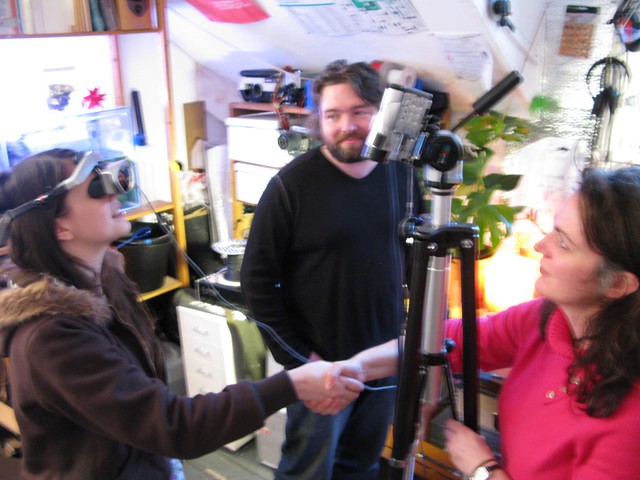As part of my research into perceptual illusions, I looked into The ‘Rubber Hand Experiment’. This is a classic low tech experiment that can help us “understand how sight, touch and “proprioception” the sense of body position, combine to create a convincing feeling of body ownership, one of the foundations of self-consciousness (Nature 1998, vol 391, p 756 )”. Recent studies have gone on to experimentally induct of out of body experiences or create body swap illusions. See the work of Henrik Ehrsson and Olaf Blanke. [see link http://www.eurekalert.org/pub_releases/2007-08/ucl-foe081407.php ] I invited some psychologists to the studio [including Lizzi Lewis of BEAM Lab and Paul Sermon] who I have expertise in this area, they brought presentations and some kit to do the rubber-hand experiment, most importantly a realistic rubber-hand [which I since discovered is not really needed] with Head Mounted Displays, and a DV camera we had everything we needed to experimentally induct an out of body experience!

I was amazed at how well the rubber hand illusion worked. In this experiment, the fingers of the rubber hand are stroked synchronously with the real hand [hidden from view]. You see the rubber hand in place of your own. It took a long time for me but as the illusion kicked in I began to feel a strong connection with the fake rubber-hand. I felt the unnerving sensation that the rubber hand was in fact, my own hand, and always had been. It felt that at any moment I could start to move the hand. It started to feel heavy, and this made my arm start to ache.
To be honest, before I tried this I was slightly sceptical of this experiment, I was not convinced that the effect could be strong, total, or convincing’. For me there were several stages; a weirdness at the beginning, where I thought nothing more was going to happen; this then increases as your real hand starts to feel very odd. Then there is a drifting and an odd numbness as you begin to connect with the rubber-hand, this connection then becomes strong, and even remains if visual contact is broken with the hand briefly.
I had an idea to try a wooden hand, and this worked surprisingly well. It made me feel as if my hand was shiny hard and smooth. This left me wanting to push this experiment further; What happened if you swapped the hand for a modified hand during the experiment, used fewer fingers or increasingly abstracted the hand progressively? Or used a hand with just 3 fingers or a beast hand with hair and claws? Lizzi Lewis brought a set of other hands made with rubber gloves and with different textures which she uses as part of her research.


Given my scepticism about the rubber-hand experiment, I am now convinced that the Body swap illusion could create a very strong sensation of being removed from one’s own body or simulate the effect of an out of body experience. Next time to do this experiment effectively, we need more space and time to set up with less visual distractions in the space.